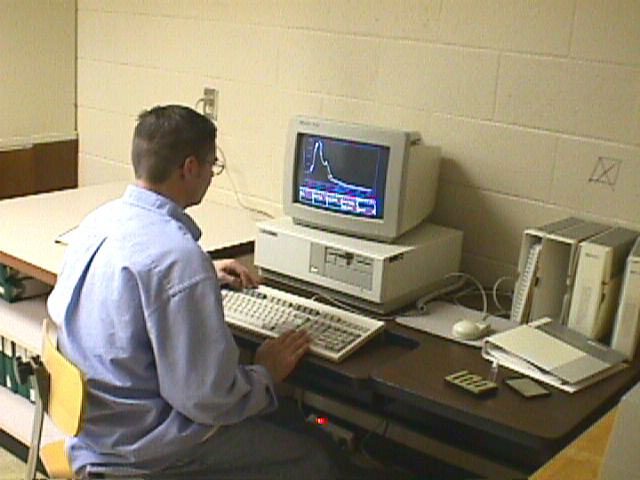|
Inorganic Chemistry |
Experiment 4 |
Spring 2025 |
Infrared and Electronic Spectra
Introduction
In experiment two, you found correlation tables for organic
and inorganic compounds. In this experiment, you will obtain the IR and
visible spectra for an unknown compound. From this data, you will
identify the class of compounds from a list of unknowns.
IR study
Obtain an unknown to be run on the Nicolet iS10 FT-IR
spectrophotometer. The sample will be run as a Nujol
mull. The mull is prepared by placing enough sample to thinly cover a
dime in your mortar (the bowl) and grind with the
pestle. Then add a drop of Nujol (or mineral
oil) and grind again. You want to have a sample with the consistency of
tooth paste. Adjust by adding either more sample or mineral oil.
Place a small drop of the mixture in the center of the NaCl salt plate (use
gloves when handling the salt windows to avoid contamination) and cover with
the second salt plate. Gently push the two salt plates together to spread
out the sample. Be careful not to make the sample too thick or too thin.
For reference, you should obtain the IR spectra for NaNO3 and Na2SO4.
Clean the salt plates with acetone. Do NOT use
water on the salt plates.
Visible spectrum
The visible/ultraviolet spectrum is associated with
electronic transitions in the compound. In the transition metal
complexes, many of these transitions occur in the visible region of the
spectrum. The spectrum obtained here is unlike the IR spectrum, in that
it does not give "fingerprint" regions that aid in the structure
determination. However, once a spectrum is known, it is indicative of
that  particular compound. Many transition
elements do have characteristic colors in solution. Once you obtain your
spectrum, be sure to discuss the relationship between the color of the solution
and the absorbance maxima in the spectrum. (Hint: find the visible
light spectrum with the corresponding wavelengths for the different colors).
particular compound. Many transition
elements do have characteristic colors in solution. Once you obtain your
spectrum, be sure to discuss the relationship between the color of the solution
and the absorbance maxima in the spectrum. (Hint: find the visible
light spectrum with the corresponding wavelengths for the different colors).
Sample preparation: dissolve approximately 30 - 50 mg
of sample in approximately 5 mL of water. The exact concentration is not
important for this experiment. Place the sample in a cuvette and
obtain the spectrum using the HP8452A spectrophotometer. Print the
spectrum. Be sure to turn off the lamp when finished. Do not use
organic solvents to clean the plastic cuvettes. Rinse with distilled
water and let air dry.
Write-up
The report must follow the guidelines on the Lab Report
page. The minimum report should include an introduction explaining how each
instrument works (in theory) and what information each instrument gives about
the compound, the spectra and a discussion of your results. The report
will be due by 5:00 pm on Friday, April 4, 2025. This lab will be worth
30 points of your lab grade. No late reports will be
accepted.
|
Possible
Unknowns |
|
|
Cu(NO3)2 |
CuSO4 |
|
Fe(NO3)2 |
FeSO4 |
|
Co(NO3)2 |
CoSO4 |
|
Mn(NO3)2 |
MnSO4 |
|
Ni(NO3)2 |
NiSO4 |
|
Zn(NO3)2 |
ZnSO4 |
|
UO2(NO3)2 |
UO2SO4 |
|
(NH4)2Fe(NO3)4 |
(NH4)2Fe(SO4)2 |
Colors of hydrated metal ions (from Wulfsberg, Principles
of Descriptive Inorganic Chemistry, p. 33)
|
Ti+3,
violet |
Ce+3,
colorless |
Pa+4,
colorless |
|
V+3,
blue |
Pr+3,
green |
|
|
V+2,
violet |
Nd+3,
lilac |
U+3,
red-brown |
|
Cr+3,
violet |
Np+4,
yellow-green |
|
|
Cr+2,
blue |
Pm+3,
pink |
Np+3,
purple |
|
|
Pu+4,
tan |
|
|
Mn+2,
pale pink |
Sm+3,
yellow |
Pu+3,
blue-violet |
|
Fe+3,
pale purple |
Am+4,
red |
|
|
Fe+2,
pale green |
Eu+3,
pink |
Am+3,
pink |
|
Sm+2,
red |
Cm+4,
yellow |
|
|
Co+2,
pink |
Gd+3,
colorless |
|
|
Eu+2,
colorless |
||
|
Ni+2,
green |
Tb+3,
pink |
|
|
Cu+2,
blue |
Dy+3,
yellow |
|
|
Ho+3,
yellow |
||
|
Er+3,
lilac |
||
|
Tm+3,
green |
||
|
Yb+3,
colorless |
Others:
UO2+2, yellow
Zn+2, colorless
